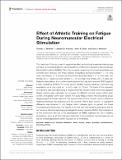Effect of Athletic Training on Fatigue During Neuromuscular Electrical Stimulation
Author(s)
Abitante, Thomas J.; Rutkove, Seward B.; Duda, Kevin R.; Newman, Dava J.
Downloadfspor-04-894395.pdf (1.865Mb)
Publisher with Creative Commons License
Publisher with Creative Commons License
Creative Commons Attribution
Terms of use
Metadata
Show full item recordAbstract
<jats:p>The purpose of this study was to explore the effect an individual's exercise training type will have on muscle fatigability during repetitive contractions induced by Neuromuscular Electrical Stimulation (NMES). Thirty-four subjects comprising of competitive athletes and controls were recruited into three cohorts: Endurance (runners/cyclists) <jats:italic>n</jats:italic> = 13; nine male, four female; 27 ± 8 years old, Explosive (Lifters/Sprinters) <jats:italic>n</jats:italic> = 11; nine male, two female; 30 ± 7 years old, and controls <jats:italic>n</jats:italic> = 10, six male, four female, 26 ± 4 years old. Subjects were placed in a custom-made leg extension rig, and received NMES against a fixed resistance (NMES-FR), to the Vastus Medialis muscle resulting in isometric leg extensions, at a duty cycle of 1 s on/3 s rest, for 20 min. The force of the isometric contractions was recorded using a Hogan MicroFet2 dynamometer, and three separate fatigue metrics were calculated to compare the different cohorts, sports within each cohort, and gender within each cohort. For every fatigue metric, the endurance group fatigued significantly less than both the explosive and control cohorts, with no difference observed between the explosive and the controls. Within each cohort, no significant difference was observed in any fatigue metric between sport or gender, but these comparisons lacked power. The results show that only high capacity endurance activity will have any effect on reducing one's fatigability during repetitive NMES. The implications of this conclusion can aid in the development of NMES regimens for use in healthy populations, such as athletic training or astronaut musculoskeletal countermeasures, as well as clinical applications when fatigue is to be minimized.</jats:p>
Date issued
2022-06-14Department
Harvard University--MIT Division of Health Sciences and Technology; Massachusetts Institute of Technology. Media Laboratory; Massachusetts Institute of Technology. Department of Aeronautics and AstronauticsPublisher
Frontiers Media SA
Citation
Abitante, Thomas J., Rutkove, Seward B., Duda, Kevin R. and Newman, Dava J. 2022. "Effect of Athletic Training on Fatigue During Neuromuscular Electrical Stimulation." 4.
Version: Final published version
ISSN
2624-9367